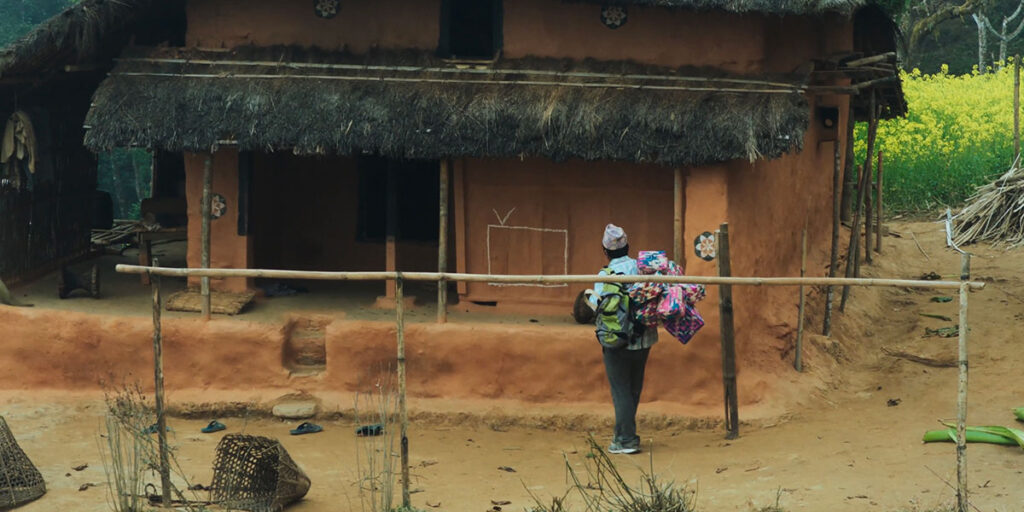A little boy borrows a needle from a neighbor to use for his makeshift paper pinwheel. After playing for a little while, he then calls out to his father Maila (Dayahang Rai) in the distance, the latter with bamboo canes in tow. Maila gazes lovingly at his son, Bindre (Prasan Rai), a tender moment that hints at a close relationship between father and son.
Nabin Subba’s latest film, “A Road to a Village” (Nepali: “गाउ आएको बाटो”), is an examination of the human condition. It explores the dynamic between parent and child; and how the promise of opportunity and modernity affects the relationships between members of this intimate family.
When ‘A Road to a Village’ Presents Opportunities and Challenges in Equal Measures
“A Road to a Village” introduces us to Maila, a basket weaver living a simple village life in the mountainous region of eastern Himalayas of Nepal. Though the film hints at his outbursts, Maila nonetheless is a loving husband to his wife Maili (Pashupati Rai) and father to their seven-year-old son, Bindre.
The film’s title refers to a road that was finally built to their village, something the village folk see as a blessing. We see them blessing the very first bus that arrived in their area, along with their excitement at having to experience amenities they never never knew existed. Fascination for sodas, television, and hip-hop music become part of the new normal, clearly affecting the tranquility the village once held.

Working on a screenplay he co-wrote with Mahesh Rai, Director Nabin Subba essentially utilizes two vantage points from hereon. As modern amenities creep in, Maila’s life begins to unravel. As a basket weaver, he suddenly sees his trade not appealing anymore to his neighbors who just discovered the cost-effectiveness of tarpaulins for their everyday household use. With his trade being the family’s only source of livelihood, Maila finds himself trapped between sticking to tradition at home or going beyond the village to survive.
The film also follows Bindre, a little boy full of mischief and curiosity as are a boy’s wont. He regularly picks fights with a particular classmate he doesn’t like, begrudgingly studies and outright rebels when electricity is down, and tears pages off his textbook to use as paper planes. With the impending urbanization of their village, Bindre uses his resourcefulness to get closer to the benefits the new road brings.
Existentialism amid Promises of Modernity
With Josh Herum’s camerawork and Heidi Li’s haunting music complementing his direction, Subba captures the feelings of fear, excitement, and uncertainty of his characters. After all, these people face the prospects of having to continue surviving in a world that’s leaving them behind. Maila, in particular, represents the strains in parental responsibilities. And this especially applies in cultures where it is the men who need to take charge. Granted, the road to their village offers opportunities for him to provide more; but if anything, it also questions his ability to provide for his family.
A pivotal scene in the film happens when Maila sees a friend return to the village from working as an immigrant laborer, bringing with him extravagant gifts for his family. This, needless to say, requires said friend to leave his family for a considerable amount of time. However, seeing Bindre coveting the same luxuries begins to weigh on Maila; giving him second thoughts whether to sell his trades outside the village to earn more.
Related Review: ‘Return to Dust’ is a Tender Examination of Human Connection amid a Worldview Shaped by Cultural Traditions
On Searching for One’s Purpose — and the Validation Such Pursuit Involves
This, I believe, is why “A Road to a Village” works: Maila’s internal turmoil serves as a philosophical exploration of the human condition. This is a universal struggle shared by individuals in an ever-changing world where the promise of progress often clashes with the desire to safeguard cultural heritage and personal identity. And with Dayahang Rai’s performance affecting the audience in more ways than one, we ride along as he ponders pursuing a better life for his family.
The film ends in a thought-provoking way, with a note written in Nepali plastered at the back of a bus.
“Papa please come back home soon.
I don’t need the TV.”
And as renowned Nepalese singer Rajesh Payal Rai begins singing the Heidi Li-penned theme song “Aa Langne,” one can’t help but feel a lump in their throat.
Tackling the themes of progress, tradition, and the indomitable spirit amid the changing of the guard; “A Road to a Village” is a philosophical inquiry into the human condition.